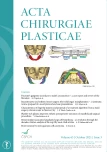-
Medical journals
- Career
Is it a second scrotum?
Authors: Gino Vissers 1,2; Katrien Smets 3; Thierry. Tondu 1,2; Filip Thiessen 1,2
Authors‘ workplace: Department of Plastic, Reconstructive and Aesthetic Surgery, University Hospital Antwerp, Edegem, Belgium 1; Faculty of Medicine and Health Sciences, Antwerp University, Wilrijk, Belgium 2; Department of Dermatology, GZA Sint-Augustinus Hospital, Wilrijk, Belgium 3
Published in: ACTA CHIRURGIAE PLASTICAE, 63, 3, 2021, pp. 150
Dear Sir,
We would like to share a peculiar presentation of a superficial lipomatous naevus at the right inner thigh of a male patient, resembling the patient's nearby located scrotum.
A 35-year-old man presents with a slowly growing lesion on his right inner thigh. The lesion has been present for a few years. It makes the patient self-conscious but causes no other symptoms. The patient has no previous medical history and no family history of skin disease.
Clinical examination reveals a saccular lesion on the right inner thigh. It is a solitary, soft and skin-coloured lesion, resembling the patient’s nearby-located scrotum (Fig. 1). Ultrasound imaging shows a subcutaneous fatty content with no deep connections and no visible vasculature.
Fig. 1. Overview (A) and close-up (B) photos of the lesion at the patient’s right inner thigh that has been present for a few years. The colour, texture and firmness mimic the patient’s nearby-located scrotum. 
Resection under local anaesthesia is performed for cosmetic reasons (Fig. 2). Histopathological examination reveals a superficially subcutaneously located lipomatous lesion with mature, white adipose cells and polypoid transformation, compatible with naevus lipomatosus cutaneous superficialis (also called superficial lipomatous naevus or “fat naevus”). There is no dysplasia and immunohistochemical staining with Murine Double Minute 2 (MDM2) to rule out liposarcoma is negative.
Fig. 2. Intraoperative photo of the lesion that was successfully resected under local anaesthesia. No recurrence occurred. 
A superficial lipomatous naevus is an idiopathic, cutaneous hamartoma that was first described by Hoffman and Zurhelle in 1921 [1]. It is defined by the presence of the aggregates of mature, ectopic adipocytes among the collagen bundles of the dermis. Typically, the lesions are either congenital or present by the third decade of life with no sex predilection.
A superficial lipomatous naevus is clinically classified into two types: classical or solitary. The classical form presents as multiple clusters of soft, skin-coloured nodules that mainly occur in the pelvic-girdle area. They have a zosteriform pattern and may either be sessile or pedunculated. The solitary form presents as a single, pedunculated, skin-coloured lesion that may occur anywhere on the body [2].
A superficial lipomatous naevus can be left untreated as it is a benign condition. In our case, resection under local anaesthesia was performed for cosmetic reasons. Its resection is usually curative.
Financial disclosures: None of the authors has a financial interest in any of the products, devices, or drugs mentioned in this manuscript.
Gino Vissers, MD
Department of Plastic, Reconstructive and Aesthetic Surgery
University Hospital Antwerp
Drie Eikenstraat 655
B-2650 Edegem
Belgium
e-mail: ginovissers@doctor.com
Sources
1. Hoffmann E, Zurhelle E. Über einen Naevuslipomatodes cutaneus superficialis der linkenGlutäalgegend. Archiv für Dermatologie und Syphilis 1921, 130(1): 327–333.
2. Lynch FW, Goltz RW. Nevus lipomatosus cutaneus superficialis (Hoffmann-Zurhelle); presentation of a case and review of the literature. AMA Arch Derm. 1958, 78(4): 479–482.
Labels
Plastic surgery Orthopaedics Burns medicine Traumatology
Article was published inActa chirurgiae plasticae

2021 Issue 3-
All articles in this issue
- Reconstructive and esthetic breast surgery after solid organ transplantation – a systematic review, proposal of a novel protocol and case presentations
- Characteristics of fingertip injuries and proposal of a treatment algorithm from a hand surgery referral center in Mexico City
- Platelet-rich plasma improves esthetic postoperative outcomes of maxillofacial surgical procedures
- Breast implant-associated anaplastic large-cell lymphoma – an evolution through the decades: citation analysis of the top fifty most cited articles
- Bone invasion by oral squamous cell carcinoma
- Three-dimensional navigation in maxillofacial surgery – the way to minimize surgical stress and improve accuracy in fibula free flap and Eagle’s syndrome surgical procedures
- Is it a second scrotum?
- Professor Radana Königová Prize awards
- Editorial
- Fournier’s gangrene secondary to male’s circumcision – a case report and review of the literature
- Acta chirurgiae plasticae
- Journal archive
- Current issue
- Online only
- About the journal
Most read in this issue- Bone invasion by oral squamous cell carcinoma
- Platelet-rich plasma improves esthetic postoperative outcomes of maxillofacial surgical procedures
- Breast implant-associated anaplastic large-cell lymphoma – an evolution through the decades: citation analysis of the top fifty most cited articles
- Characteristics of fingertip injuries and proposal of a treatment algorithm from a hand surgery referral center in Mexico City
Login#ADS_BOTTOM_SCRIPTS#Forgotten passwordEnter the email address that you registered with. We will send you instructions on how to set a new password.
- Career
